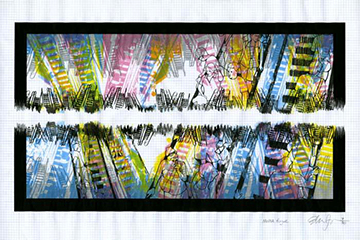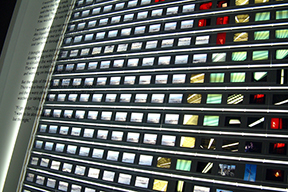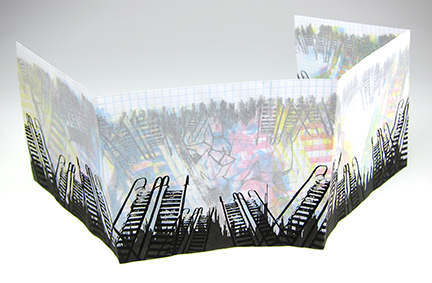
Edwin Jager
![]() Iconometer is a serial artist’s book that I’ve been producing for almost twenty years. I started the project as a way to play around with ideas and interests through the medium of the ’zine but over the years, it’s evolved into an interesting hybrid of book arts, publishing, and printmaking. I’ve developed it into a broad platform of personal and artistic exploration.
Iconometer is a serial artist’s book that I’ve been producing for almost twenty years. I started the project as a way to play around with ideas and interests through the medium of the ’zine but over the years, it’s evolved into an interesting hybrid of book arts, publishing, and printmaking. I’ve developed it into a broad platform of personal and artistic exploration.
The latest issue, #47 is titled, MoMA Fugue, and it exemplifies how I use Iconometer as a tool for investigation and experimentation. I had the opportunity to create this  piece while I was the Visiting Artist at the Paper Fox Printmaking Workshop at Lawrence University in Appleton, Wisconsin. I printed a serigraph that could exist in two important states: as a small edition of signed and numbered prints and trimmed and folded to become an issue of Iconometer.
piece while I was the Visiting Artist at the Paper Fox Printmaking Workshop at Lawrence University in Appleton, Wisconsin. I printed a serigraph that could exist in two important states: as a small edition of signed and numbered prints and trimmed and folded to become an issue of Iconometer.
Key inspiration for this issue can be found in the research for my Liquid into My Skin project. It’s a series of installation and sculptural works that assemble photographic transparencies into visual mosaics. This work led me to the paintings and experimental films created by Hans Richter, in collaboration with Viking Eggeling. Like many of their contemporaries, they were researching non-objective compositions of abstract shape and color. A good example of this is found in Richter’s work, Orchestration of Color from 1923, which composes brightly colored squares on a black background. As they moved these abstractions into the medium of film, they looked to Johann Sebastian Bach’s fugues and counterpoint for inspiration. The movie, Rhythmus 21, also from 1923, illustrates this approach of creating what Malcolm Cook called, “visual music”.
 With #47, I wanted to create a similar “orchestration of color” but instead of building my compositions with abstract shapes, I turned to my collection of motion studies for content. I have captured many sequences of photos where I have placed the camera in a strategic location and then used the continuous shutter mode to record a series of still images of people moving through the frame. I find the resulting patterns that are created to be really fascinating and reminiscent of the work of Eadweard Muybridge’s catalogues of motion or Frank Gilbreth’s efficiency studies.
With #47, I wanted to create a similar “orchestration of color” but instead of building my compositions with abstract shapes, I turned to my collection of motion studies for content. I have captured many sequences of photos where I have placed the camera in a strategic location and then used the continuous shutter mode to record a series of still images of people moving through the frame. I find the resulting patterns that are created to be really fascinating and reminiscent of the work of Eadweard Muybridge’s catalogues of motion or Frank Gilbreth’s efficiency studies.
I used both drawing and digital manipulation to transform a series of photographs that I took of people riding the escalator at the Museum of Modern Art in New York. I combined this imagery on the page with the graphic representation of Bach’s Die Kunst der Fuge to provide a visual thread that pulls the viewer linearly through the page but also breaks up and disrupts the imagery, accentuating the movement. With this particular format, I had the opportunity to play a lot with the page and the viewer’s interaction. It begins as a closed book and is revealed as a series of spreads until the entire composition is exposed. Once the page is opened completely, the abstract color and form coalesces into a more clearly defined subject, with mirrored forms, illusion of depth and layers of visual information printed on both sides of the translucent sheet. As the piece was evolving, I became increasingly intrigued by the stained-glass effect that I was achieving. I think it’s fitting that the images are from the Museum of Modern Art in New York as it reminds me of other artist’s interpretations of the modernist “cathedral”, such as Lyonel Feninger’s woodcut print that illustrated the Bauhaus manifesto, or Kurt Schwitters’ Cathedral of Erotic Misery from his Hannover Merzbau.
 Iconometer is a small and intimate publication. For my subscribers, and myself, it’s fun to read the new issues but it’s also intriguing to see how they fit within the continuum of Iconometer. With #47, I wanted to allow the dialog between the folded book (movie) and the flat print (window) to be unrestricted by a binding . I turned the cover into a sleeve that serves as the container for the book. As with every issue, I have to consider not only my ideas and the rendering of the subject matter but also how I will package the content within the context of the project. It’s a small vessel but it can hold a lot. If you would like to learn more about Iconometer and my other work, please visit my website: edwinjager.net
Iconometer is a small and intimate publication. For my subscribers, and myself, it’s fun to read the new issues but it’s also intriguing to see how they fit within the continuum of Iconometer. With #47, I wanted to allow the dialog between the folded book (movie) and the flat print (window) to be unrestricted by a binding . I turned the cover into a sleeve that serves as the container for the book. As with every issue, I have to consider not only my ideas and the rendering of the subject matter but also how I will package the content within the context of the project. It’s a small vessel but it can hold a lot. If you would like to learn more about Iconometer and my other work, please visit my website: edwinjager.net
Edwin Jager is currently an Associate Professor of Art at the University of Wisconsin Oshkosh where he teaches courses in graphic design. He earned an undergraduate degree in printmaking from the Ontario College of Art and Design, an MFA from the University of Iowa and also earned a Graduate Certificate in the Arts and Technologies of the Book from the University of Iowa Center for the Book. Using sculpture, print, photography, text, and drawing, he explores the book as a physical and cultural artifact. Recent exhibitions include: The Open Book, Ypsilanti, Michigan; Book As Vessel, Jacksonville, Florida; and The Beautiful Book, Denver, Colorado. His work is also found in numerous institutional collections in the United States and Canada.




